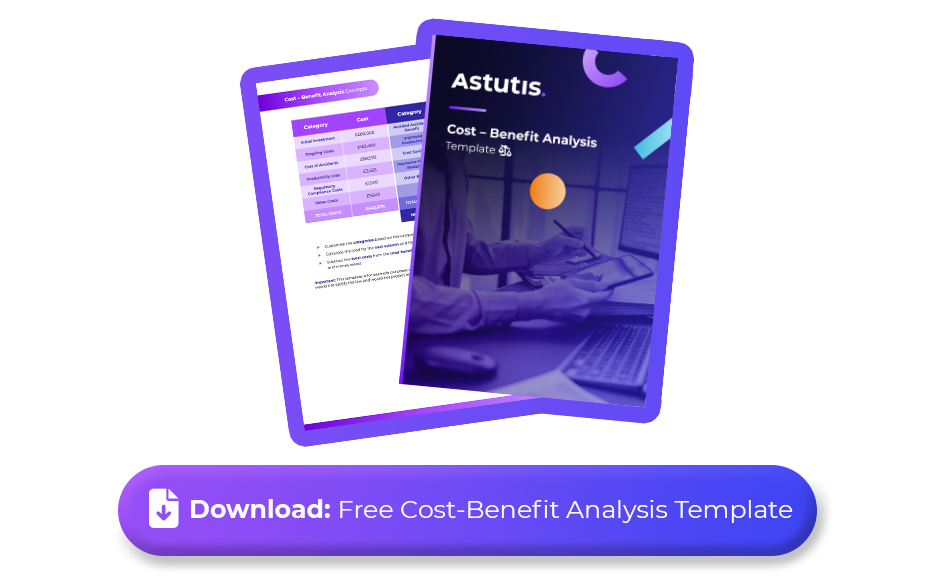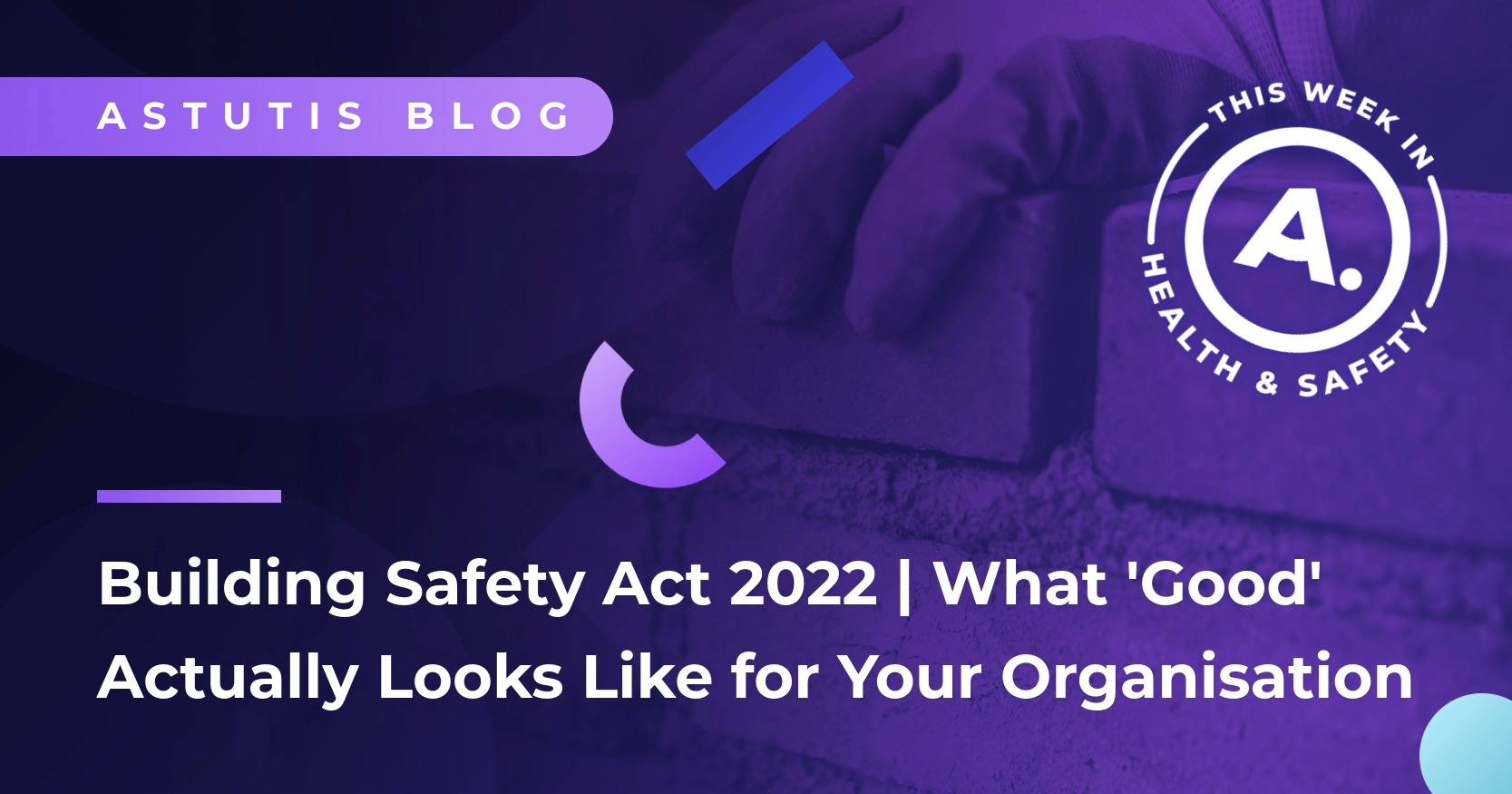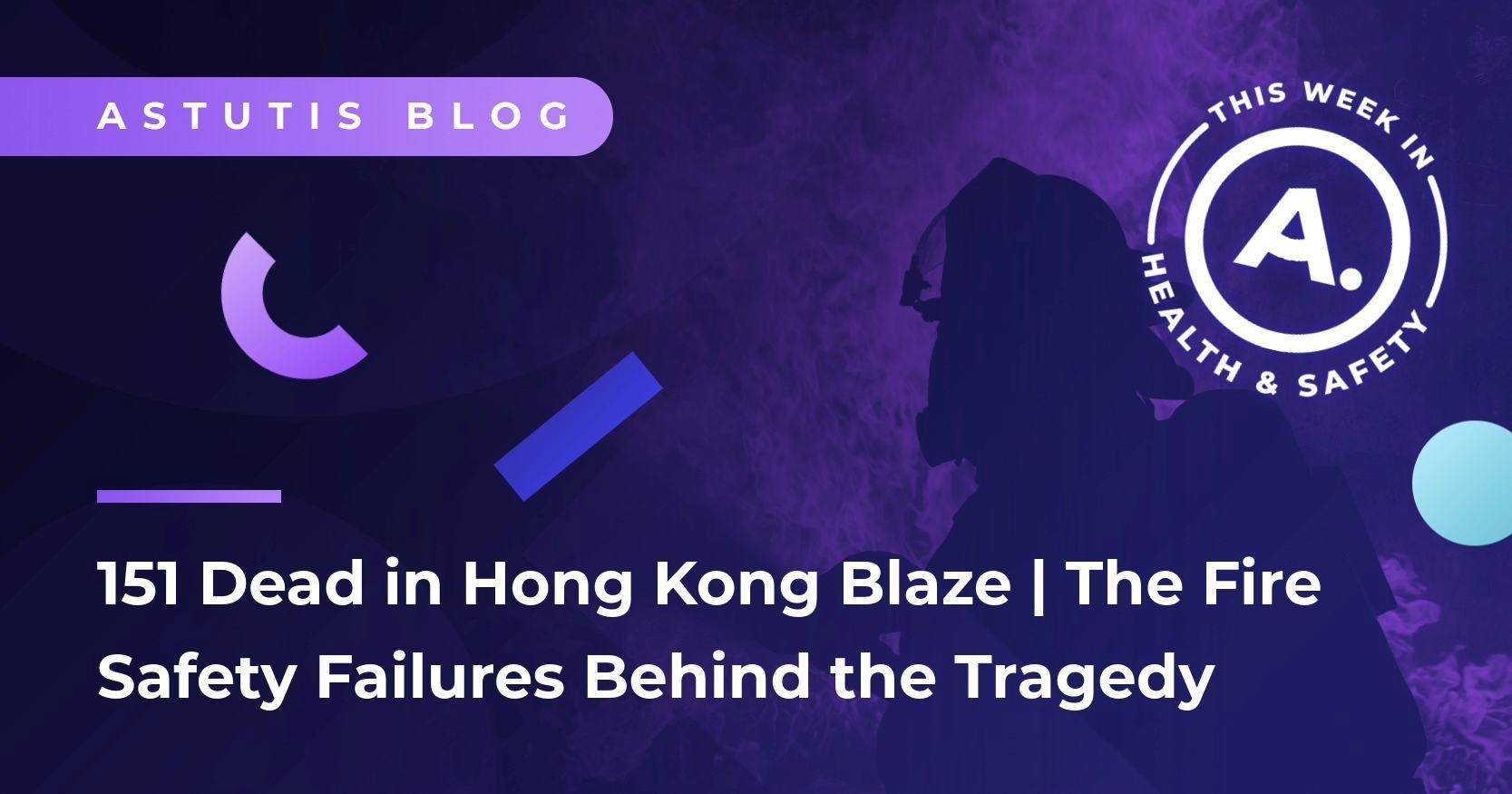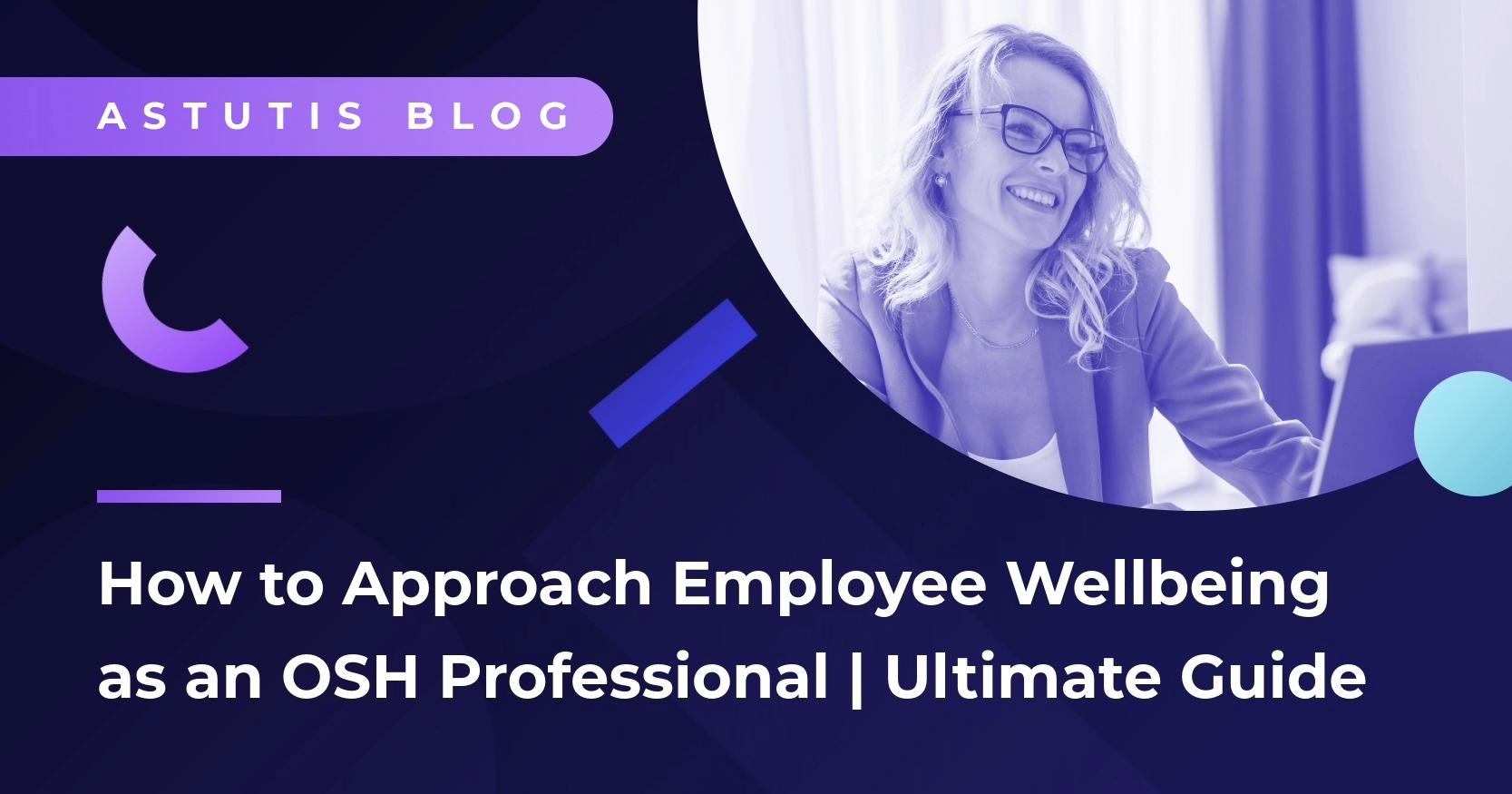Free Cost-Benefit Analysis Template for Health and Safety: A Practical Guide
Making the right decisions for your organisation when controlling risk is a complex process that requires forethought and adequate planning. When weighing up the pros and cons of a decision, a cost-benefit analysis for monetary savings is an excellent tool for health and safety professionals to utilise.
What Is a Cost-Benefit Analysis?
A cost-benefit analysis (CBA) is a tool for evaluating the costs and benefits of a monetary investment. It considers both internal and external costs and benefits and attempts to measure them in economic terms.
For health and safety professionals, it’s a valuable tool when you want to avoid bias in your decision-making process and helps to underpin your discussions with stakeholders to explain why an investment needs to be made.
Why Should You Conduct a Cost-Benefit Analysis?
A cost-benefit analysis may be undertaken to support general commercial decisions or, specifically, in the health and safety context to help determine whether or not a particular risk control measure is necessary to ensure safety as far as is reasonably practicable.
Something is reasonably practicable unless its costs are extremely disproportionate to the benefits. In simple terms, if costs divided by benefits are greater than the disproportion factor, then the measure can be considered not worth doing for the amount of risk reduction achieved.
Benefits of a Cost-Benefit Analysis
Conducting a Cost-Benefit Analysis (CBA) in health and safety provides several practical, financial, and strategic benefits for organisations.
Stakeholder Support
For many health and safety professionals, we often find ourselves fighting for more spend from stakeholders to mitigate health and safety risks. Putting together a cost-benefit analysis will help you put forward a persuasive case to senior management, finance teams and board of directors.
Turning safety proposals into financial language improves the likelihood of gaining support, funding, or fast-tracking approvals.
Informed Decision Making
Cost-benefit analyses helps employers to make evidence-based decisions about whether a health and safety safety intervention is necessary. It clarifies whether the expected benefits justify the investment.
Justifying Investment
They demonstrate the financial value of investing in health and safety improvements. The unfortunate reality of the business world. However, a cost-benefit analysis turns health and safety into a business case, showing how it saves an organisation money.
Prioritisation of Resources
Allows you to compare multiple potential initiatives. When budgets are limited, cost-benefit analyses help you to prioritise the control measures that offer the greatest return on investment in terms of injury and legal protection.
How to Conduct a Cost-Benefit Analysis
Conducting a CBA for health and safety can be broken down into four simple steps for organisations. They are as follows:
- Step One: Identify All costs and benefits.
- Step Two: Measure the monetary values of each cost and benefit.
- Step Three: Consider the likelihood of the cost or benefit occurring.
- Step Four: Take account of the time of the costs and benefits, discounting accordingly. £1000 today is worth more than £1000 benefit in 10 years.
To identify costs and benefits, use the principle of opportunity cost. An opportunity cost is the forgone benefit that would have been derived from a risk control benefit. Examples of lost opportunities in health and safety include people having to stand idle or being unable to produce at their regular jobs because they are redirected to deal with the consequences of an accident.
Example Cost-Benefit Analysis for Health and Safety
From my personal experience, this is an example of what a cost-benefit analysis might look like for a health and safety scenario. Let's say a manufacturing company is considering installing machine guarding on three of it's production machines to reduce the risk of entanglement injuries.
| Costs | ||
|---|---|---|
| Cost | Detail | Estimated Amount (£) |
| Capital Cost | Purchase and installation of machine guards on three machines. | £15,000 |
| Training Cost | Staff training on use and inspection of new guards. | £2,000 |
| Downtime Cost | One day if production downtime during installation. | £3,000 |
| Ongoing Maintenance | Annual maintenance and checks. | £1,000/year |
Total Costs | £20,000 |
| Benefit | ||
|---|---|---|
| Type of Benefit | Detail | Estimated Amount (£) |
| Injury Reduction | Avoiding one major injury per year (average cost per major injury including legal, compensation, lost productivity.) | £25,000/year |
| Insurance Savings | Lower employer liability premiums. | £1,500/year |
| Productivity Gains | Reduced stoppages and investigations. | £3,000/year |
| Legal Compliance | Avoidance of estimated fines and prosecution from the Health and Safety Executive. | £5,000/year |
| Total Annual Benefit | £34,500/year |
Your Free Downloadable Cost-Benefit Analysis Template
Download your free cost-benefit analysis below and keep reading to discover what you should include when doing your calculations.
What Should You Include In a Cost-Benefit Analysis?
Cost-benefit analyses include a wide range of costs and benefits. It is essential to be thorough, and individual risk decisions should be itemised where sub-costs underpin the final figure for full transparency.
Costs
All appropriate costs must be included. The costs considered should only be those needed for implementing the control measure (not the deluxe version).
- Initial Investment: Refers to the upfront expenses required to implement risk control measures, such as purchasing safety equipment or conducting training programs.
- Ongoing Costs: Recurring expenses associated with maintaining and sustaining risk control measures over time, e.g. equipment maintenance and ongoing training programs.
- Costs of Accidents: The financial impact incurred due to workplace accidents or incidents, e.g. medical treatments, compensation for injured employees and legal fees.
- Productivity Loss: The monetary value of decreased productivity resulting from workplace hazards or accidents, e.g. disruptions to workflow caused by safety issues.
- Regulatory Compliance Costs: Expenses associated with ensuring compliance with safety regulations and standards such as audits, obtaining permits, etc.
- Other Costs: This category encompasses any additional expenses not covered but relevant to risk control.
Benefits
All benefits of a measure should be included. If a risk reduction measure is identified for one type of accident but reduces other risks, e.g., health risks, all benefits should be counted.
- Avoided Accidents Benefit: The value of preventing or mitigating workplace accidents through effective risk control measures, e.g. avoiding medical expenses and fines or penalties.
- Improved Productivity: Financial gains resulting from enhanced productivity achieved by implementing safety measures, e.g. improved employee morale and greater efficiency.
- Cost Savings: Savings from cost-effective risk control measures. These include savings from optimising resource utilisation, reducing waste, etc.
- Insurance Premium Reduction: The reduction of insurance premiums resulting from improved safety measures. In specific industries, insurance providers offer lower premiums for organisations with robust health and safety processes.
- Other Benefits: Financial benefits not covered by the above sections but resulting from effective risk control measures, e.g. improved reputation and reduced liability.
Accurately quantifying these costs and benefits allows organisations to conduct a comprehensive analysis of their risk control decisions. By comparing them, organisations can evaluate the financial viability and effectiveness of control measures and make decisions to prioritise resources and optimise safety and well-being in the workplace.
When Can You Learn More About Cost-Benefit Analysis?
A cost-benefit analysis is an essential tool in the repertoire of any health and safety professional. It is one of many tools covered as part of the NEBOSH Level 6 Diploma, the gold standard qualification for those looking to progress to a senior health and safety leadership position.
Risk assessments and other decision-making tools and practices for leadership are available as part of the course. Once successfully passing the course with Astutis, learners will also be able to:
- Source, develop, evaluate, and interpret relevant health and safety information (such as legislation, guidance, best practice, and procedures) and communicate it effectively to those who need it.
- Continually develop your professional skills and ethics to actively influence improvements in health and safety by providing persuasive arguments to workers at all levels.
- Develop a health and safety policy strategy within your organisation (including proactive safety, Corporate Social Responsibility and the change management process).
To learn what else the NEBOSH Level 6 Diploma can teach you and how it will shape the future of your career, visit our course page. There, you can view our pre-purchase course guide and answers to the most frequently asked questions.

Real Life Stories










